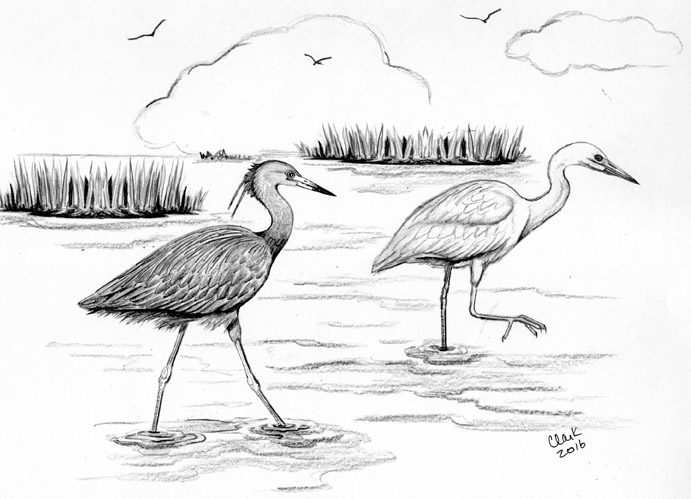
Dear Bird Folks,
My son (who is in the second grade) and I were taking a bird walk along a cranberry bog near our house, when we spotted what we think is a Little Blue Heron. Just thought you’d like to know in case you wanted to check it out.
– Melanie and Ryan, East Orleans, MA
This is so cool, Melanie and Ryan,
For the second week in a row I’ve gotten a tip from a mother and her young son, who go birding together. That’s so awesome! Attending a soccer game or swim meet is one thing, but slogging around a cranberry bog is not what many moms like to do…or what many boys like to do with their moms. It makes me wish that my mother were still around to go birding with. Hey, maybe I should invite my ninety-one-year-old mother-in-law to go birding with me. Nah. I could never keep up with her.
Little Blue Herons are fairly rare on Cape Cod, so I was naturally skeptical when Melanie (and Ryan) walked into my shop and told me that she and Ryan had seen one. But instead of grilling Melanie with a series of ID questions, I simply turned to Ryan and said, “What do you think, dude? Was it a little blue?” He gave me a slight smirk and a head-nod so filled with confidence that I immediately stopped all further questioning. I could tell this second grader knew his stuff.
The bog’s location isn’t far from my house, so I told Melanie that Casey and I would check it out on our way home from work. When we arrived at the bog the sun was setting and things were getting dark fast. At this point, only the red-wings were still active and everything else had settled down for the evening. We spent ten minutes scanning and saw nothing unusual until I noticed something white in the thickets on the far side of the bog. Since Casey has younger eyes than I do, I asked him if the white object was a bird or a piece of trash. He flipped up his binoculars and decided it was a white plastic bag. Still not convinced, I dug my spotting scope out of the trunk of my car and focused it across the bog. This is when the white plastic bag turned and stared back at me. Melanie and Ryan were 100% correct; there was indeed a Little Blue Heron at the bog. Nice job, you two.
Right now some folks might be wondering, “If the bird is called a ‘Little Blue Heron,’ why is it white?” This is the most impressive part of the discovery. For the first year of their lives Little Blue Herons, which are basically the same size and shape as a Snowy Egret, are all white. Thus, most casual birder watchers, and even serious birders, may pass over a tall white bird; mistakenly, thinking it’s the far more common Snowy Egret. But not the dynamic duo of Melanie and Rya; they totally zeroed in and got it right. The second remarkable part of the discovery is the bird’s location. It wasn’t found in the Monomoy National Wildlife Refuge, or in the great Nauset Marsh or in some other noted bird sanctuary. This bird was discovered in a tiny secluded bog, smack in the middle of overdeveloped East Orleans. Whodathunkit?
Typically, Little Blue Herons are found in the southeastern states. As their name indicates, they are considerably smaller than our stately Great Blue Herons. Little blues are the only herons that start off white, but then change to blue (with purplish necks and heads) before their first birthday. Researchers don’t really know why they start off white, but one theory is that being white allows them to go undetected while feeding next to the more aggressive Snowy Egrets. Eventually, the herons will not only molt into their namesake blue coloring, but they’ll also become slightly antisocial. Adult Little Blue Herons tend to feed alone and in isolated locations (such as a secluded Cape Cod bog).
Changing colors may have saved Little Blue Herons from extinction. A hundred years ago hunters craved the long white nuptial plumes found on breeding egrets. This greed led to the slaughter of thousands of birds. Fortunately, no one wanted blue feathers and thus the Little Blue Herons weren’t targeted. (Although many of them needlessly became victims of the dreaded collateral damage, but no one ever likes to talk about collateral damage.)
It would be nice if this Little Blue Heron stayed and nested on the Cape, but that’s not likely to happen. There are only a handful of Little Blue Heron nesting locations in Massachusetts, and as far as I know, Cape Cod isn’t one of them. Also, Little Blue Herons typically don’t breed until their second year, so this young bird is probably only here to enjoy the bog’s free frogs and tadpoles. Fortunately for the bog owner, herons don’t like to eat fresh cranberries…they much prefer Craisins.
Congrats on finding the Little Blue Heron, Melanie and Ryan! Many birders regularly search local “famous” birding sites, but the mundane locations are often overlooked. It’s nice to know that an inconspicuous bog, in the middle of fancy East Orleans, is being surveyed with such accurate eyes. And to think that I almost dismissed the whole thing as a white plastic bag. Although, in hindsight, I should have known right away that the white object I saw in the distance couldn’t possibly have been trash. Everyone knows white trash is not allowed in East Orleans.